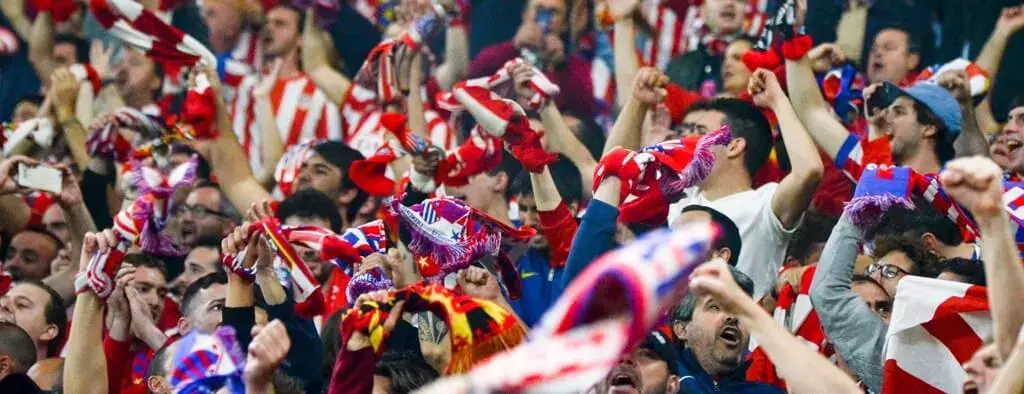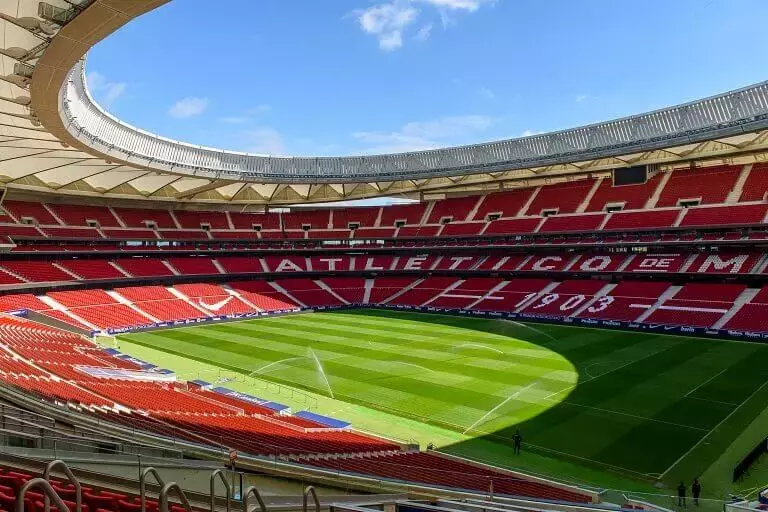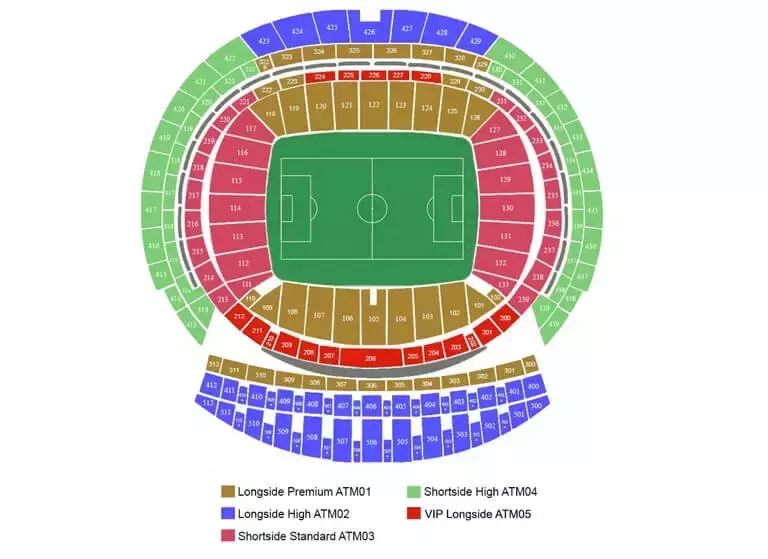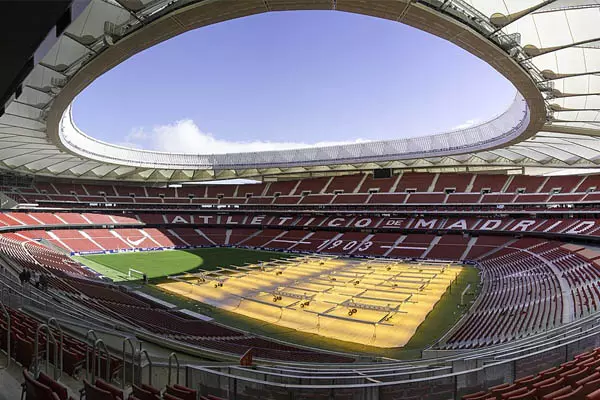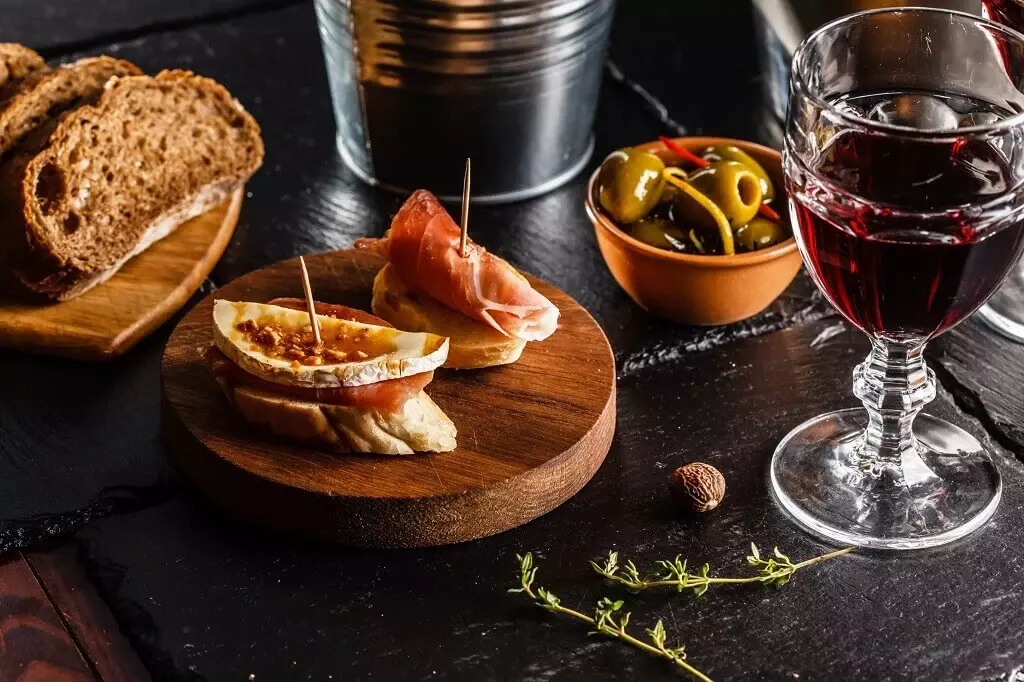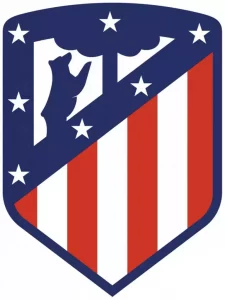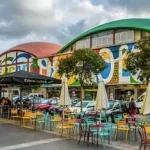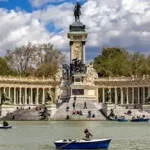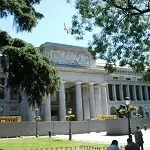Tip! Make sure you have a valid ticket. + Read more
- Paper or e-tickets
- A carefree experience
Atlético Madrid
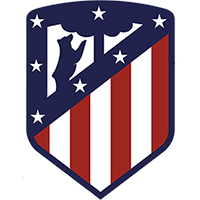
Football trip
Atlético Madrid

Tip! Make sure you have a valid ticket. + Read more
- Paper or e-tickets
- A carefree experience
Tip! Make sure you have a valid ticket. + Read more


Tip! Make sure you have a valid ticket. + Read more
On your visit to Atlético Madrid, you will enjoy the sizzling atmosphere of the impressive stadium. The Estadio Wanda Metropolitano is one of the most comfortable stadiums globally, with a great view of the field from any spot. Even more impressive are the club’s fans, called ‘Los Suffradors’ because of the many ups and downs they have endured. The singing, jumping and flag-waving goes on for ninety minutes. Goosebumps guaranteed!
In addition, you will have enough time to discover beautiful Madrid. Marvel at the many sights and enjoy delicious tapas on one of the many terraces.
We have picked out the best tips to make sure you get the most out of your trip to Atlético Madrid. From practical information around the Wanda Metropolitano stadium to suggestions for exploring Madrid.
Initially, supporters were not too happy about the forced departure from the almost sacred Vicente Calderón stadium, where Atlético played its matches for 51 years. This imposing structure was best known for the busy four-lane road that ran under one of the main stands. However, work on the motorway caused so much damage to the stadium that crowd safety was no longer guaranteed. A move was unavoidable. Fortunately, the fans got a fantastic stadium in return.
Indeed, since the 2017-2018 season, Atlético Madrid has been playing in the immense Wanda Metropolitan stadium. The name is a tribute to one of the club’s previous stadiums, the Metropolitan Stadium, where Atlético played its matches from 1923 to 1966. The fans prefer to talk about the ‘Metropolitano’, as ‘Wanda’ is the name of the stadium’s Chinese name sponsor.
The stadium seats 68,456 spectators, making it the third-largest stadium in Spain after Camp Nou (Barcelona) and Santiago Bernabéu (Real Madrid).
The football stadium is equipped with the latest gadgets and was the first 100% LED stadium globally. It also has 1,000 parking spaces inside the stadium and 3,000 outside. It has won several awards and hosted the 2019 Champions League final between Liverpool and Tottenham Hotspur. Add the great atmosphere provided by the passionate supporters, and you are guaranteed an unforgettable experience!
The Wanda Metropolitano stadium is located in the district of Rosas, 11 kilometres north-east of Madrid city centre. Despite this distance, the stadium can be reached easily and quickly by public transport.
By Metro
Travelling by metro is by far the best option to get to the stadium. Metro station ‘Estadio Metropolitano’ is located right next to the stadium. It is the biggest station of the whole Madrid network. The dimensions are truly colossal, as the construction considered the thousands of fans who use the line during the matches.
To get here, take metro line 7 (Hospital del Henares – Pitis). Allow 45 minutes from the centre of Madrid, including a change at Pueblo Nuevo (line 5), Avenida de America (lines 4,6 and 9) or Gregorio Maranon (line 10).
Some fans prefer not to go straight to the stadium, but walk the last part. It is a special experience to be among the other fans while the locals set up stalls to sell food and drinks to the marching crowd. If you don’t want to miss it, get off at La Rosas (line 2), Canillejas (line 5) or Las Musas (line 7) stations. From these stations, it is about a 15-minute walk to the stadium.
By Bus
EMT Madrid buses that come to the stadium are the lines 28, 38, 48, 140, 153, E2 and the night buses N5 and N6.
By Train
The Spanish train company, Renfe, will take you to Coslada station with line C2 or C7. However, this station is still more than five kilometres away from the Atlético stadium, so you will have to change to metro line 7 at the same station. Two stops later, you will get off at the stadium.
By taxi
It is also possible to travel from the city centre to the stadium by taxi. Expect to travel 12 kilometres (around 30 minutes) and to pay around €22.
Address details Wanda Metropolitano
Wanda Metropolitano
Avenida de Luis Aragones 4
28022
Madrid, Spain
The Wanda Metropolitano has three rings. Because during construction, the choice was made to prioritise fan comfort over maximum capacity, the distance between rows is greater than in most other stadiums. The seats are, therefore, quite comfortable. In addition, 96% of the seats are covered.
The sides of the stadium are:
As a result, you sit a little further away from the field than on the other stands. Here you will also find the VIP boxes, the Presidential box and most of the VIP seats.
A visit to Atlético Madrid is not complete without a stadium tour and a tour of the immense club museum. You can choose to only visit the museum or book a stadium tour, including a visit to the museum. Tickets can be ordered online in advance, so you are guaranteed a seat and save a few euros as well.
Stadium tour
From Tuesday to Sunday, a guided tour of the stadium takes place several times a day, except on match day. Explanations are given in both Spanish and English. During the hour-long tour, you will have access to the changing rooms of Atlético and the away team (check out the differences!), the press room, the massage room and the trainer’s room. Through the players’ tunnel, you walk onto the field and take your place in the dug-out. You can then visit the club museum on your own.
For a combi ticket, you pay €22 online; at the stadium itself, it is €24.
Children up to 14 years of age can enter for €18.
Museum
If you do not have time for a stadium tour, you can also just visit the ‘Territorio Atleti’ museum. It is located on the west side of the stadium, next to the Club Store.
The museum is over 1400 m in size2 and shows the history of the club from its foundation in 1903. You will find all the Atlético shirts through the years and experience historical moments of the club’s history with virtual reality goggles. Of course, you can see all the trophies in the trophy cabinet, including the World Cup. Be sure to allow at least an hour and a half for this visit.
The museum is open from Tuesday to Sunday, from 11.00 to 18.00 (last admission).
Online you pay €14 for a ticket; at the box office, it is €16.
Children up to 14 years of age receive a €4 discount.
Museo on avoinna tiistaista sunnuntaihin klo 11.00-18.00 (viimeinen sisäänpääsy).
Verkossa maksat 14 €; lippukassalla se on 16 €.
Alle 14-vuotiaat lapset saavat 4 €alennuksen.
The area around the Wanda Metropolitano does not quite have the allure that used to surround the Estadio Vicente Calderón. The time that thousands of fans went on foot to the La Latina district to start the third half is definitely over. Nevertheless, there are plenty of atmospheric places to eat in the streets around the stadium. In addition, many fans choose to return to the city centre after the final whistle and to chat in one of the many sports bars. There, too, football fans have a few outspoken favourites. We will help you on your way.
This tapas bar, at Calle de Suecia 90, offers quality food at a great price. The cod is highly regarded, but the squid and hamburgers are also very tasty. There are also several gluten-free dishes on the menu.
Just down the road, at Calle de Suecia 102, is this popular bar, praised above all for its welcoming and attentive service. Before and after the game, the atmosphere here is excellent, and you’ll be served ice cold beer and excellent tapas in no time. As alcohol is not served in the stadium, many Atlético supporters come here for a Cerveza.
S10bar, at 56 Calle Guzman El Bueno, is known as the best sports bar in town. Modern, home-made, tasty and cheap’ is its motto, and that is not saying too much. You can watch various matches on the many TV screens, while enjoying a Balotelli Burger, Diegoletta Maradona sandwich or a Muhammed Ali Steak.
At Calle de Alcalá 59, close to the Retiro metro station, sits this very popular sports bar. The place is not too big, but watching a match on the screen with other football fans creates a great atmosphere. The bar serves a wide range of beers. A live band regularly plays Irish folk music.
Atlético Madrid was founded in 1903 by three Basque students as a daughter club of their favourite club from the Basque country, Athletic de Bilbao. In 1920, this link was severed and Atlético became independent.
Although the club won several titles in the 1950s and 1960s, Atlético’s golden age was in the 1970s. In eight years, three league titles were won. In 1974, the club even reached the final of the European Cup 1, where Bayern Munich proved too strong. The Germans, however, were not keen on a duel for the World Cup for club teams. Atlético took their place and defeated Argentine Independiente 2-1. This makes Atlético the only club in the world that has a World Cup in its trophy cabinet, but no European Cup I.
In 2014 and 2016, Atlético reached the final of the Champions League, but both times city rival Real Madrid proved too strong. Nevertheless, the club’s trophy cabinet is well stocked, with 11 championship trophies, 10 national cups and 4 Supercups. In addition, Atletico has won the Europa League three times and the European Cup 2 once.
Atlético has one real archrival: the bigger city rival Real Madrid. The rivalry is not only explained in sporting terms, but also has to do with the different backgrounds.
Real Madrid represented the royal family and the wealthy class and came from the rich North. Atlético, on the other hand, originally came from the South and was popular with the working class. Nowadays, that division is quite outdated: both clubs have supporters in all walks of life. Felipe VI, the current King of Spain, is even a passionate fan of Atlético Madrid.
The logo of Atlético Madrid has been changed many times over the years. The last time was in 2017 when the logo was modernised due to the move to the new stadium.
What has remained the same since 1917 are the red, white and blue colours and the image of a bear under a mulberry tree. This image is taken from the coat of arms of the city of Madrid. Legend has it that this area was once a gathering place for bears (at Puerto del Sol, Madrid’s main square, there is a large unmissable statue of this scene).
Finally, the seven white stars represent the number of provinces bordering Madrid, as well as the stars of the constellation ‘Big Bear’.
Atlético Madrid has been playing in the same colours since 1911: a red and white striped shirt, blue trousers and red socks. The colours of the shirt also gave Atletico its nickname “Los Cochoneros” (the mattresses). Spanish mattresses used to have a red and white cover. The club also owes its other nickname, “Los Rojiblancos” (the red-whites), to the shirt.
In the early years of the club, the shirt was half blue and half white. Atletico Madrid played in the same shirt as their parent club Athletic Bilbao, which in turn adopted these colours from England’s Blackburn Rovers.
In 1909, Bilbao sent a staff member to England to buy new shirts for both Bilbao and Madrid. The blue and white shirts were not to be found, so he returned to Spain with the red and white striped shirts of Sunderland. Then both Athletic Bilbao and Atlético Madrid decided to play in these new colours. An additional advantage was that red and white textiles were widely available in Spain, as mattress covers were the same colour. However, Atlético decided to continue playing in the blue trousers of Blackburn Rovers.
In the lively Spanish capital, it is almost impossible to choose from the many sights to see. World-famous museums, beautiful parks, squares and churches are everywhere. This is why we have listed some of the highlights for you.
Don’t miss out on this historic working-class district during your visit to Madrid. La Latina offers hours of wandering through its winding streets, past numerous restaurants, bars and antique shops. Take a look at the old market hall, where locals stock up on fresh meat and vegetables. Every Sunday morning, a huge flea market takes place, where you will surely find something to your liking.
The impressive Retiro Park, once a private park of the royal family, is not to be missed. Retreat from the hustle and bustle of the city and enjoy the many sculptures and fountains. Visit the artificial lake with its beautiful colonnade, where you can also rent a rowing boat. Or take a stroll along the many street musicians, portrait painters and fortune-tellers.
Close to the city park, you will find the Prado, one of the biggest and most famous art museums in the world. The museum is especially famous for its collection of almost 10,000 paintings, by Goya, Rembrandt and Pieter Bruegel, among others. As an art lover, you will undoubtedly spend hours in this immense building. Admission tickets cost €15, but by booking online, you can avoid the long queue.
Make your trip a real groundhop tour. For example, visit Real Madrid’s impressive Santiago Bernabéu. There are several daily guided tours, where you visit the museum, the catacombs and the field. We recommend you book online in advance. You can then be sure of a place, and you pay less than at the stadium itself.
Our 2nd trip with football break.
Opted for budget hotel which was 2mins from city centre - excellent location.
Seats at Atl Madrid stadium were ideal, worth paying the extra for.
We stayed on for couple of days to explore this vibrant city.
Tip: Cable car well worth a trip to see city from different angle.
This visit to Madrid was the 4th trip I have booked with Football Break. The site is so easy to use and flexible with the flight and hotel options. I have booked similar trips before by booking everything separately but it is just so easy to do it all in one place and at competitive rates. The flight times suited me and the hotel was exceptional value and in a great position for seeing Madrid. The match itself was well worth it and the we had a great view of the pitch in a brilliant stadium, Wanda Metropolitan.
We also did the tour of the San Bernabeu whilst in Madrid.
Tip: My tip for Madrid is to get a multi-day metro ticket at the airport terminal station and make the most of it to see the city, plenty to see in Madrid but not all close together.
Another excellent trip , every aspect was perfect, Madrid a vibrant and exciting city. The atmosphere at the match was amazing!
Tip: Metro is the best option for travelling to the stadium. Not much in way of food around the stadium.
Everyone went very smoothly, tickets and any other documentation were delivered promptly a week in advance. Any questions I had before the trip were responded to very quickly through email. Madrid was a great city with plenty to do. Although the Wanda stadium was around half an hour out of Madrid, it was quick and easy to get a taxi. Drinks aren't overpriced and there are restaurants everywhere you look!
tip: Take a taxi to the Wanda stadium as opposed to the subway, as the subway confused us! (Although that might just have been us)
This was our third trip with Football Break and once again they didn’t disappoint. We decided to take in a midweek Champions League match and it was well worth the trip. The hotel was pretty basic but we knew that before we went. We could have upgraded the hotel but when you’re only sleeping there, there didn’t seem much point. The location was central in Madrid and there were plenty of shops, restaurants and bars near to us. The match itself was unbelievable! The atmosphere before the game was electric and it carried on for the full 90 minutes. The Atleti fans never stop singing and the new stadium is something to behold. It’s a bit out the way from the centre of Madrid, but it’s a fantastic stadium with all the mod cons. Overall, another great trip away, we have another one planned for March, this time Barcelona and I’m sure it’ll be just as great as this trip was.
tip: The Wanda is quite a way out of the city centre of Madrid but we used the subway to get there. Cheap and very easy to use. And after the game, have a browse in the stadium shop for maybe 20 minutes which lets the crowd die down getting back out.
The package was fantastic all round. The information all came through via email in good time prior to the trip. The flight selection option made it easy to select where and when you wanted to travel. The hotel was a slight upgrade (€20 each) but it was super clean, convenient and comfortable. The match tickets were easy to print and seats amazing. I would definitely use the company again for future trips.
tip: Definitely get a metro card to last your stay as it is absolutely brilliant value. Also explore off the main squares in the little backstreets. Some lovely bars and restaurants to be found!
Everything went according to plan. We had a great time and I will definitely be using Footballbreak again. Thank you.
Excellent - a fantastic weekend away
Footballbreaks is the best in the business, great trip with my son from start to finish at great a price ! thank you
What a great trip. My son and I visited from Friday through to Monday to see the Atletico game. We have used this service 7 times previously and every time we have had a great time. On this particular trip everything was superb, the flights, hotel and seats at the stadium. I would highly recommend this as a trip as the new Atletico stadium is definitely worth a visit. We will definitely be booking our eighth trip for next season.
Tip: use the metro to get from the airport to your hotel and generally getting round the city for longer trips as it is really easy to use. A lot of Madrid is within walking distance but the metro is cheap and quick if a longer trip.
